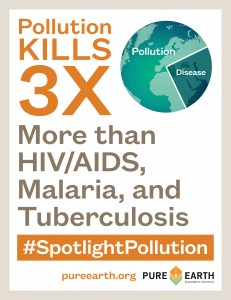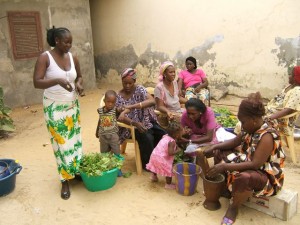UPDATE: Our voices are being heard at the U.N. Our call to #SpotlightPollution in the Sustainable Development Goals (SDGs) is making a difference. We’ve received 26 letters of support from governments, agencies, NGOs & universities. As a result, the zero draft of the SDGs released in late June has expanded the language on pollution to include “water and soil.”
The Open Working Group (OWG) met for the 13th time in July and continues its discussion of pollution as part of the post-2015 goals.
But it is not over. We need to ensure that pollution remains in the final SDGs. We need to continue to #SpotlightPollution. You can help. Sign and share this petition to help us spread the word.
It is a global emergency.
It kills about 8.4 million people a year and causes three times more deaths than HIV, malaria and tuberculosis combined.
The good news is that we know how to stop it.
The bad news is that the world seems to be turning a blind eye to its destruction.
This global killer is pollution.
New analysis of data from the World Health Organization (WHO) by the Global Alliance on Health and Pollution points to pollution as the #1 cause of death in the developing world. Yet, pollution is virtually being ignored in the Sustainable Development Goals (SDGs), which are currently being decided.
This week, the U.N.’s Open Working Group (OWG) on the SDGs is meeting in New York for its 12th session to refine and determine post-2015 goals. We are at the U.N. following it closely, working hard to make sure all voices about pollution are heard. It might be one of the final few opportunities we have to persuade the world to pay attention to the issue of pollution in the SDGs.

We are glad that support for our position is growing worldwide among countries, organizations, environmental and health experts, and other individuals.
You can help. Sign and share this petition to help us spread the word.
Since the SDGs will determine what the world pays attention to over at least the next 15 years, and how funding to poor countries is allocated, it is crucial that all aspects of pollution is addressed in the SDGs.
Pollution: The invisible Killer
When the U.N.’s Open Working Group (OWG) on the SDGs met for the 11th session in May, we became alarmed when we learned that the focus on the health impact of pollution was greatly reduced in importance in the SDGs. In current drafts of the SDGs, pollution is mentioned only as a sub item in passing, and only air pollution is considered in the health objective.
At the recent Global Environment Facility (GEF) meeting in Mexico, pollution was also ignored. While about 1,000 people gathered to discuss climate change and biodiversity, the one event focused on pollution drew only 25 people to a side conference room for an hour.
This tendency to ignore pollution is worrying because the deaths of more than 8 million men, women and children in 2012 alone should not be an afterthought on the world’s agenda.
If the issues of poverty and sustainable development are the focus of the SDGs, pollution sits squarely in that intersection.
94% of the burden of disease from pollution falls on the poor in low- and middle-income countries that are least equipped to deal with the problem. Because it is no longer a huge health problem in the west, we seem to have forgotten about it. But in the poorer countries, it is the biggest cause of death of all.
“There is a reason why pollution is sometimes called the invisible killer,” says Richard Fuller, President of Pure Earth/Blacksmith Institute.
“While it is the single largest risk factor, unfortunately, its impact is difficult to track because health statistics measure disease, not pollution.”
“Pollution causes diseases like cancers, lung infections, and heart disease amongst others. Hospitals don’t measure what caused those diseases. But contaminated water, soil and air result in millions of additional diseases and deaths.”
“These are deaths we can avoid, if we prioritize addressing pollution.”
The Past, Present and Future
While climate change needs to be addressed to preserve our future, pollution cannot be ignored because it concerns our present.
For solutions, we just need to look at our past.
Cities in Europe and the U.S. that were once cloaked in pollution are now clean and livable because we have low-cost, workable solutions. We just need to apply these solutions to the developing world. Poor countries need access to that expertise and funding to implement them. And the SDGs will allow us to do that.
Strengthening the focus on pollution in the SDGs will force this global health crisis from the shadows into the spotlight so that it will no longer be known as the invisible killer.
In the poorest villages and cities across the world, many of the deaths from pollution are not noticed by anyone except the victim’s families.
Often, the poisoned poor often do not understand that their community is polluted, and they do not know why their children are dying.
 For many like Seynabou Mbengue, it is already too late. The woman from Ngagne Diaw, Senegal, lost five children to pollution. They all fell ill with the same symptoms, and one by one, they all died before the age of five. Her toddlers were among some 32 children known to have perished from a lead poisoning outbreak
For many like Seynabou Mbengue, it is already too late. The woman from Ngagne Diaw, Senegal, lost five children to pollution. They all fell ill with the same symptoms, and one by one, they all died before the age of five. Her toddlers were among some 32 children known to have perished from a lead poisoning outbreak
Her story is just one of millions we should tell so the world takes notice. Pollution’s toll has too many faces to ignore.
Join the Global Alliance on Health and Pollution to demand the need to spotlight pollution in the SDGs so that this global killer will not go unchecked. We have the solution. Now we just need the world to pay attention.
Sign and share the petition now.





